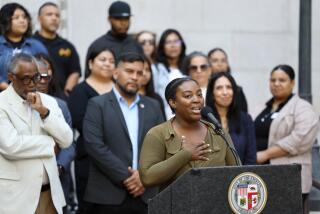Hard Times Increase Reach of Summer Lunch Program
They probably didn’t have places like Burbank in mind when they designed the program to feed low-income kids.
But 25 years after Congress created the Summer Food Service Program, Burbank is serving the free lunches for the first time.
It is a vivid illustration, anti-hunger advocates say, of the changing face of poverty in Southern California and the nation.
Born during the era of Lyndon B. Johnson’s War on Poverty, the summer food program was created to ensure that low-income children get at least one nutritious meal a day when the National School Lunch Program--which offers free and reduced-price meals during the school season--was not operating. Under the summer program, lunches are distributed at local parks or other public facilities.
But decades later, the program faces new challenges, including year-round school calendars and increasing demand in areas far from the inner city, including rural and suburban communities such as Burbank and parts of Orange County.
“In general, it started as an inner-city program . . . but there’s a growing awareness of the program’s availability and more efforts to find pockets of poverty in otherwise affluent areas,” said Ed Morawetz, food program specialist with the U.S. Department of Agriculture in Washington.
“In one word, it’s the economy,” said Cleophus Davis, statewide director of the summer program, which is administered by the USDA. “People who previously had jobs don’t have the jobs. They don’t have the money. It gets down to economics.”
Nationwide, an average of 1.9 million children participated in the program each day in 1992, up from 1.57 million in 1988 and 99,000 in 1969. In California, the program served a daily average of 122,000 youths.
At Miller Park in Burbank one recent day, 9-year-old Justin guarded his spot near the picnic benches where a crowd of youngsters waited in line. It was 12:15 p.m. and lunch would not be served until 12:30, but Justin was hungry--and chivalry was dead.
“Cindy, she’s cutting!” he yelled frantically across the park, pointing out the culprit--a little girl with a mischievous smile--to site supervisor Cindy Dyer. “This girl right here, she’s cutting!”
When 12:30 rolled around, Justin was the first in line. Mothers came with their children or children came alone. One by one, they grabbed a brown bag and a carton of chocolate milk and staked out spots at picnic tables or beneath a shade tree.
“It was good,” Justin declared after finishing off a bologna sandwich, celery sticks, a banana and chocolate milk.
Dyer, a former teacher who has worked with the Burbank Department of Parks and Recreation for seven years, said participation in the park’s recreation program--which includes games, arts and crafts, and field trips--has increased because of the meals.
“A lot of people come just for lunch,” Dyer said. “Last year at this time, we’d have 10 to 15 kids regularly. Because of the lunch program we have 30 to 40.”
The site serves 100 meals a day on average.
Although designated for low-income families, there is little stigma attached to the program, Dyer said. Many of the kids know each other from the neighborhood and because Miller Park qualifies as a so-called open site, anyone under the age of 18 who shows up can get a free meal. There are no tickets to hand in or forms to fill out.
*
Burbank officials decided to offer the meals at three parks this summer after “we were alerted that there were that many needy children,” said Teri Stein of the city’s parks department.
The program’s spread to generally middle-class suburban areas does not surprise those who work in food pantries and shelters. “We have a public perception of the face of poverty, that it’s a problem of urban blight, but people are poor all over,” said Christin Driscoll, communications associate for the Food Research Action Center in Washington.
A few years ago, officials in Orange County learned that, in spite of the county’s relative affluence, more than a quarter of parents surveyed said their children went to bed hungry.
Three years ago, there were no sponsors of the summer food service program in Orange County, Davis said. This summer there were 15 sponsors, including the Garden Grove Unified School District and the Buena Park School District.
There are numerous sites throughout the San Fernando Valley, in communities such as Reseda, Canoga Park, Sunland and Sylmar; the free meals are served throughout Riverside and San Bernardino counties, including in Barstow and a location operated by the Ft. Mojave Indian tribe.
“We’re finding more and more communities that thought that they had no need for the program now finding out that they do,” said Mike Haga, senior field organizer for the food research center.
Participation has risen and fallen over the years, in sync with the economy, the mood of the White House and the willingness of local sponsors to administer it.
Typically, the summer program is sponsored by public or private schools, city or county parks agencies, or private, nonprofit community organizations, often in conjunction with an existing summer recreation or education program.
To gain designation as an open site--the most common type of sponsorship--the location must be in an area where 50% or more of the children live in families with incomes at or below the poverty level, Davis said. Anyone under the age of 18 and the disabled are eligible to receive meals.
Still, only about 15.5% of those children who receive free and reduced meals through the school lunch program also are fed in the summer program.
Kenneth Hecht, co-director of the California Food Policy Advocates, a statewide anti-hunger organization, said low-income and working poor families in California especially need such programs because housing costs are higher here than in the rest of the nation.
“For low-income families and middle-income families, almost all of their money goes toward rent,” Hecht said. “That means that there’s very little left over for food, and by the end of the month people have run out.”
Before 1981, a location could qualify as an open site if a third of the neighborhood youth were low income, but that was changed to 50% during the Ronald Reagan Administration. The Food Research Action Center has called for changing the eligibility requirement to 40%, which would probably increase the participation in suburban communities, “where the pockets of poverty are not as intense as they are in the inner city,” Haga said.
As anti-hunger advocates try to get the program expanded, the USDA office in California is searching for ways to solve another problem: With the advent of year-round schools, officials are struggling to find sponsors to offer the “summer program” to kids during breaks that could occur in October or April.
“We have reports from teachers who say that on a Monday morning, kids will attack their breakfast or lunch as if it’s the first meal they’ve had since Friday,” said Driscoll. “Imagine when that Monday morning is three months away.”
More to Read
Sign up for Essential California
The most important California stories and recommendations in your inbox every morning.
You may occasionally receive promotional content from the Los Angeles Times.










